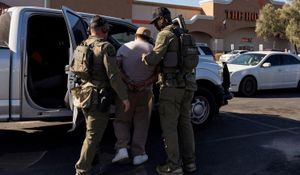A midair collision between an Army helicopter and an American Airlines regional jet resulted in the tragic deaths of all 67 individuals aboard, marking one of the deadliest aviation disasters in U.S. history. This catastrophic incident occurred on January 30, 2025, just before 9 p.m. near Ronald Reagan Washington National Airport, as the aircraft approached the congested airspace over the Potomac River.
The American Airlines Flight 5342 was carrying 60 passengers and 4 crew members, returning from the U.S. Figure SkATING Championships. The helicopter, identified as a U.S. Army Black Hawk, was on a training exercise with three soldiers onboard. Within moments of the collision, both aircraft plunged downward, resulting in a wreckage recovery operation rather than rescue efforts.
American Airlines Chief Executive Robert Isom stated, "The military aircraft came directly onto the approach path of the jet as it was landing," shedding light on the chaos of the final moments. Following the crash, John Donnelly, fire chief for the nation's capital, remarked, "We are now at the point where we are switching from a rescue operation to a recovery operation,” reflecting the grim reality faced by search teams.
Despite clear skies at the time of the incident, questions have arisen concerning the coordination between air traffic control and the helicopter crew. According to the Federal Aviation Administration, one air traffic controller was tasked with managing both helicopter traffic and incoming planes during the collision. This unusual staffing setup led to possible confusion; the controller requested visual separation for the helicopter from the arriving jet, yet the last-minute command to the chopper went unanswered before the tragic crash.
The victims included members of the SkATING Club of Boston, who were returning from training sessions at the championships held in Wichita, Kansas. Among the casualties were young figure skaters, their coaches, and the parents of the young athletes, creating tremendous grief within the skating community. Notably, coaches Evgenia Shishkova and Vadim Naumov, both former champions, were also on the flight.
Many of the passengers were understandably shattered by the news. One family member at Reagan Airport, Aster Andemicael, expressed the overarching sentiment, saying, "This is devastating." Recovery operations began immediately, with divers recovering bodies and wreckage from the icy waters of the Potomac River as the community grappled with the magnitude of the tragedy.
This collision is considered the deadliest air disaster since 2001 when the crash of American Airlines Flight 587 claimed 265 lives shortly after takeoff. Since then, aviation safety has improved markedly across the nation, making such incidents increasingly uncommon. Yet this disaster serves as the tragic high point of what many describe as growing safety concerns in the crowded airspace around Washington D.C.
The National Transportation Safety Board (NTSB) is leading the investigation to determine the cause of the collision, analyzing cockpit voice recordings and flight data. Investigators will also comb through communication logs to accurately assess the interactions between the aircraft and air traffic control officials.
Interestingly, Federal regulations surrounding the airspace have fueled debate among safety experts. Former Department of Transportation inspector Mary Schiavo remarked during interviews, "There have been questions about the setup of the airspace there,” pointing out the heightened risk involved with both commercial and military flights sharing the same routes.
Challenges have compounded with recurrent staffing shortages within the FAA, raising skepticism about whether current staff levels can reliably oversee the burgeoning demands of air travel over such congested areas.
Further complicate the situation are proposals to increase flight numbers at Reagan National Airport, which have met strong local opposition from politicians and neighborhoods concerned about aviation safety. Experts worry such actions may heighten the risk of future incidents, particularly after this recent tragedy.
Flight rescheduling efforts by major airlines are already underway, allowing passengers to adjust their travel plans without extra fees. The hope is to minimize disruption as recovery operations continue and services resume at Reagan Airport.
The ripple effects of this devastating crash will echo throughout the aviation community and the local area for years to come. Its timing, coming during what many viewed as a period of stable domestic aviation safety, reminds everyone involved of the unpredictability and inherent risks associated with air travel. The dead represented here were more than merely airline passengers; they were families, friends, and members of the community whose lives were abruptly taken.
Ongoing recovery efforts aim not only to retrieve wreckage and recover bodies but also to bring some sense of closure to those who lost loved ones and to understand how such tragedies can be mitigated to prevent future occurrences. The aviation world will be watching closely as answers unravel from this calamity.



